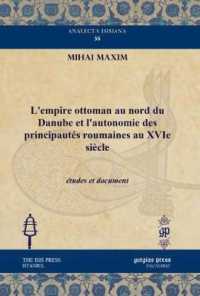- ホーム
- > 洋書
- > 英文書
- > History / World
Full Description
Explores the contemporary nature and the diverse narratives, rituals, and performances of the Navarātri Festival.
Nine Nights of the Goddess explores the festival of Navarātri-alternatively called Navarātra, Mahānavamī, Durgā Pūjā, Dasarā, and/or Dassain-which lasts for nine nights and ends with a celebration called Vijayadaśamī, or "the tenth (day) of victory." Celebrated in both massive public venues and in small, private domestic spaces, Navarātri is one of the most important and ubiquitous festivals in South Asia and wherever South Asians have settled. These festivals share many elements, including the goddess, royal power, the killing of demons, and the worship of young girls and married women, but their interpretation and performance vary widely. This interdisciplinary collection of essays investigates Navarātri in its many manifestations and across historical periods, including celebrations in West Bengal, Odisha, Karnataka, Maharashtra, Tamil Nadu, Uttar Pradesh, and Nepal. Collectively, the essays consider the role of the festival's contextual specificity and continental ubiquity as a central component for understanding South Asian religious life, as well as how it shapes and is shaped by political patronage, economic development, and social status.
Contents
List of Figures and Tables
Acknowledgments
Introduction: Movements of Navarātri
Caleb Simmons and Moumita Sen
Navarātri in the Court
1. The Splendor of the Sun: Brightening the Bridge between Mārkaṇḍeya Purāṇa and Devī Māhātmya in Light of Navarātra Ritual Timing
Raj Balkaran
2. Which Durgā? What avarātra? Remarks on Reconfigurations of Royal Rituals in the Kathmandu Valley
Astrid Zotter
3. The King and the Yadu Line: Performing Lineage through Dasara in Nineteenth-Century Mysore
Caleb Simmons
4. Dasara and the Selective Decline of Sacrificial Polity in a Former Princely State of Odisha
Uwe Skoda
Navarātri on Display
5. Politics, Religion, and Art in the Durgā Pūjā of West Bengal
Moumita Sen
6. Durgā Pūjā Committees: Community Origin and Transformed Mediatized Practices Employing Social Media
Xenia Zeiler
7. Navarātri in Benares: Narrative Structures and Social Realities
Silje Lyngar Einarsen
8. Dolls and Demons: The Materiality of Navarātri
Ina Marie Lunde Ilkama
9. Ritual Complementarity and Difference: Navarātri and Vijayadaśamī in Kāñcipuram
Ute Hüsken
Navarātri Inside
10. Bengali Durgā Pūjā: Procedures and Symbolism
Hillary Rodrigues
11. The Internal Navarātri: Sarkar baba of Benares and the Goddess Within
Jishnu Shankar
Navarātri at Home
12. Kolus, Caste and Class: Navarātri as a Site for Ritual and Social Change in Urban South India
Nicole A. Wilson
13. Display Shows, Display Tells: The Aesthetics of Memory during Pommai Kolu
Deeksha Sivakumar
14. Royal Darbār and Domestic Kolus: Social order, Creation, Procreation, and Re-creation
Vasudha Narayanan
15. Navarātra and Kanyā Pūjā: The Worship of Girls as Representatives of the Goddess in Northwest India
Brigitte Luchesi
Conclusion
Hillary Rodrigues
Contributors
Index








